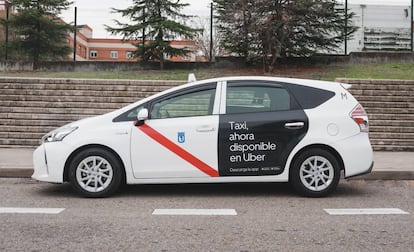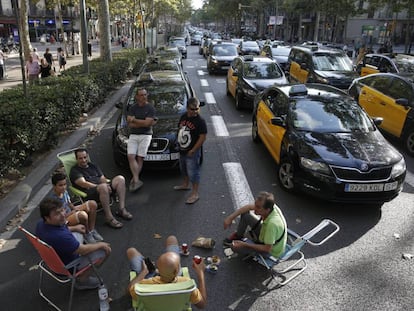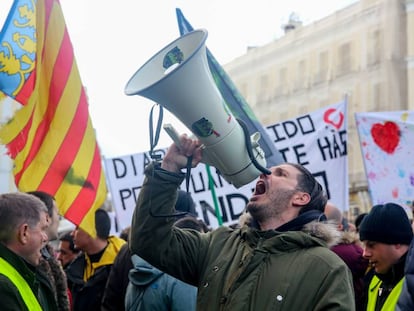After years of bitter battles, Uber adds traditional taxis to Madrid travel options
The ride-hailing company says this is the beginning of a mutually beneficial collaboration following years of confrontation between both sectors

From now on, residents of the Madrid region who use their UberX app to book a ride may get a traditional taxi instead of the usual private vehicle for hire, known in Spain as a VTC.
The added service has been available since Friday of last week, and it was made possible through a change to industry legislation, which now allows for a normal taxi to be booked in advance at a fixed price.
It’s not a zero-sum game
Juan Galiardo, director Uber Spain
“Incorporating taxis into our platform is a huge step forward for us, and we firmly believe that the alliance will be beneficial for everyone,” said Uber Spain director Juan Galiardo, who announced the initiative a month ago.
When booking a vehicle through UberX, the algorithm will offer users the closest car and inform them whether it is a VTC or a regular taxi. The process will be the same in either case: a fixed price, payment via the app, the chance to rate the driver and the choice of adding a tip or sharing the fare.
This is the essential difference between Uber and Cabify, Uber’s main competitor in Spain, which has been offering the possibility of booking a normal taxi in Madrid and Valencia since last summer, but without offering a fixed fare.

When it launched the initiative on Friday, Uber had around 50 licensed taxis available through its app, thanks to a collaboration agreement with Ciudad del Taxi, a company whose owners have both taxi and VTC licenses. Galiardo noted that the service is open to the entire taxi sector. “It’s a good example of how there is enough of a market for everyone. Any taxi driver can download the app.”
Although Uber is not ruling out other collaborations, Galiardo explained that the agreement with Ciudad del Taxi is somewhat unique, and he is convinced that when there is a minimum number of taxis signed up to the platform, no further promotion will be needed. “The idea is to start on Friday and keep growing,” he said ahead of the launch.
The company will charge taxi drivers a 12% fee on the fare without demanding any commitment in terms of length of collaboration or number of trips, the attraction being that Uber has a high rate of occupancy. “It is over 60%, compared to the 30% or 40% of a taxi,” said Galiardo. And this, in a city where the combined number of taxis and VTCs per 100,000 inhabitants is lower than in other European cities.
Galiardo declined to detail how much added income Uber expects from the new initiative, which is already underway in Paris and in several Scandinavian cities, although he did confirm that it will be one of its engines of growth in the Spanish market, which the company considers to be of strategic importance.
Warring factions
The new Uber service has been launched in the wake of a bitter standoff between traditional taxi owners and VTCs. In January, taxi drivers took to the streets of Madrid and Barcelona to protest over what they viewed as VTCs encroaching on their territory. The price of a taxi is regulated and in many areas of Spain, the stipulated ratio of one VTC for every 30 taxis is ignored. In Madrid alone, there are 15,636 taxis and 8,239 VTCs, according to the Public Works Ministry. The taxi sector also wanted the VTCs to be regulated, a task that the central government devolved to regional authorities more than a year ago.
“Don’t give the enemy an inch”
“Don’t give the enemy an inch!” This is the punchy message delivered by José Miguel Fúnez, a member of the managing board of Madrid’s Professional Taxi Federation, concerning the possibility of their taxi drivers being booked through UberX. The two private transportation systems, taxis and VTCs, have been at odds for years, and Fúnez sees little possibility that the new dual system offered by Uber and Cabify will attract a lot of taxi drivers.
“The launch [of the service] is the product of almost a year’s work,” said Galiardo. “We sat around the table with a lot of associations, companies, taxi drivers and with the authorities to adapt the operation to legal requirements. It has been said that the taxi was going to disappear. But that couldn’t be further from the truth. It is a cornerstone of urban mobility, and the way to go is to make the service more flexible and put the consumer first.”
The taxi strike had differing degrees of success. In Barcelona, VTC activity was restricted while in Madrid, the demands from the taxi drivers were ignored. “It’s not a zero-sum game,” said Galiardo. “The more alternatives there are in a city, the more mobility increases. We want to become a long-term partner in Spanish cities, working with the taxis and the authorities.”
Uber insists that the taxi drivers who sign up to their platform will benefit from their technology and consequently get more work. The technology includes maps predicting demand and the possibility of new fares coming up near destination points.
Moreover, they will be exempt from the code of conduct required of VTCs. According to Uber, the possibility of being assessed by the user will be sufficient incentive for the provision of the best service. Nor will they have to have distinctive stickers on their taxis, unless they want to.
“The launch is a milestone that hopes to relegate this tale of conflict to history,” said Galiardo.
English version by Heather Galloway.
Tu suscripción se está usando en otro dispositivo
¿Quieres añadir otro usuario a tu suscripción?
Si continúas leyendo en este dispositivo, no se podrá leer en el otro.
FlechaTu suscripción se está usando en otro dispositivo y solo puedes acceder a EL PAÍS desde un dispositivo a la vez.
Si quieres compartir tu cuenta, cambia tu suscripción a la modalidad Premium, así podrás añadir otro usuario. Cada uno accederá con su propia cuenta de email, lo que os permitirá personalizar vuestra experiencia en EL PAÍS.
¿Tienes una suscripción de empresa? Accede aquí para contratar más cuentas.
En el caso de no saber quién está usando tu cuenta, te recomendamos cambiar tu contraseña aquí.
Si decides continuar compartiendo tu cuenta, este mensaje se mostrará en tu dispositivo y en el de la otra persona que está usando tu cuenta de forma indefinida, afectando a tu experiencia de lectura. Puedes consultar aquí los términos y condiciones de la suscripción digital.
More information
Archived In
Últimas noticias
Most viewed
- Sinaloa Cartel war is taking its toll on Los Chapitos
- Oona Chaplin: ‘I told James Cameron that I was living in a treehouse and starting a permaculture project with a friend’
- Reinhard Genzel, Nobel laureate in physics: ‘One-minute videos will never give you the truth’
- Why the price of coffee has skyrocketed: from Brazilian plantations to specialty coffee houses
- Silver prices are going crazy: This is what’s fueling the rally










































